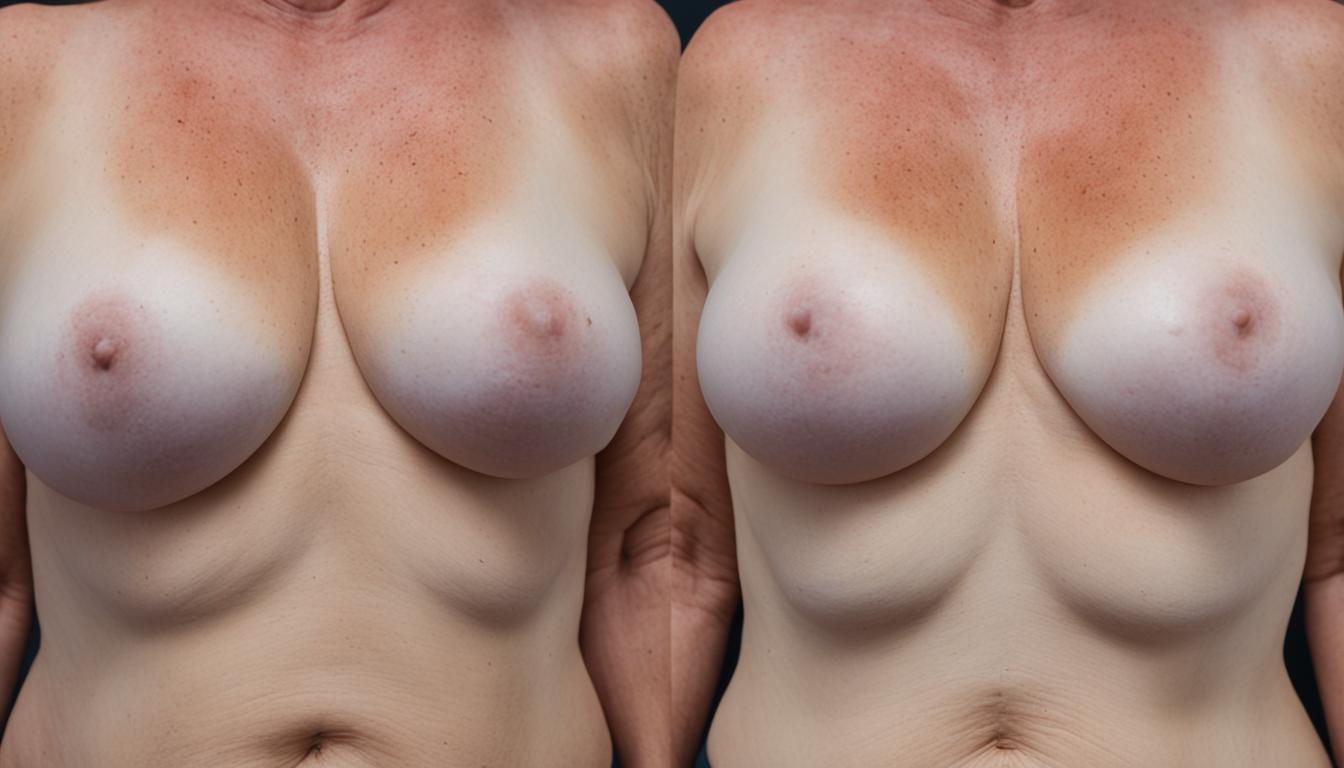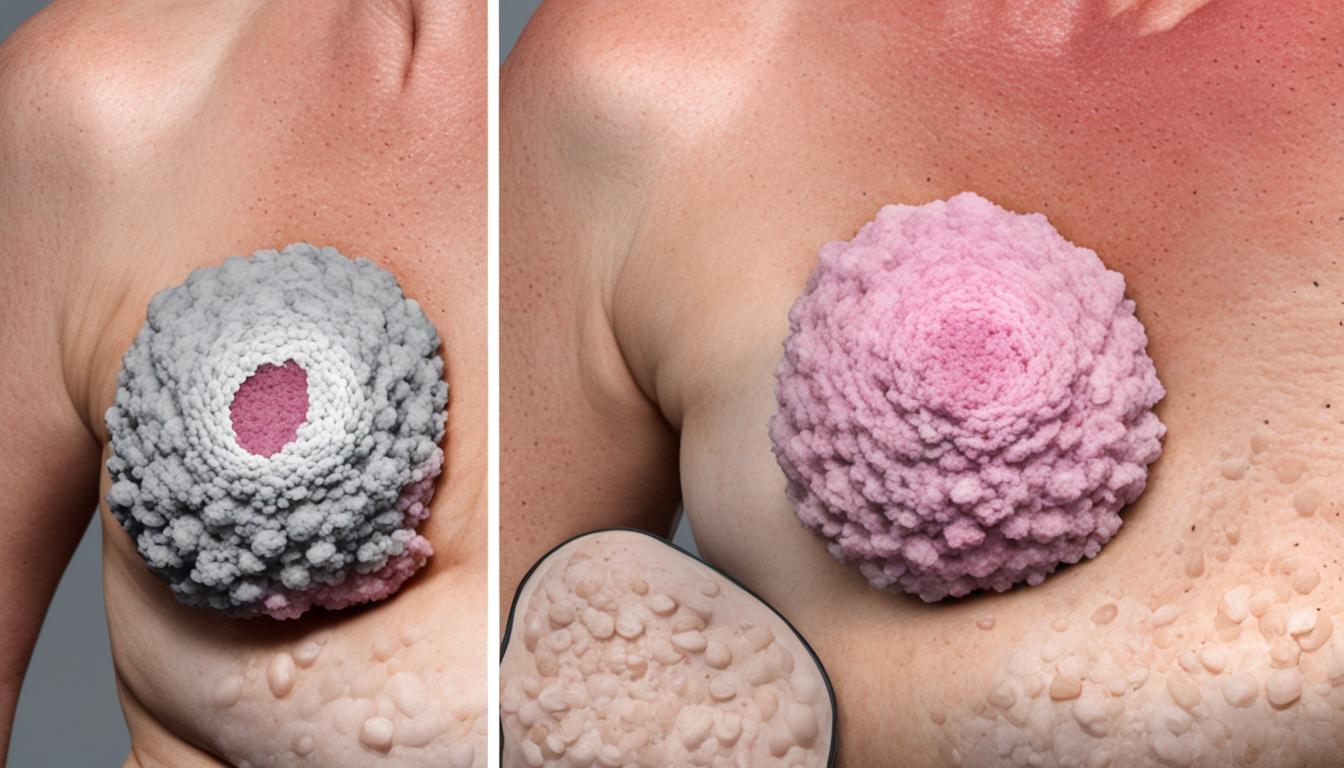Breast cancer is a common type of cancer in women around the world. Catching it early is key to better treatment and recovery chances. This guide will show you how to spot early signs of breast cancer. This way, you can take care of your breast health early.
Knowing what symptoms to look for helps you act fast if you see something wrong. Experts in healthcare and breast cancer detection have shared their knowledge with us. This ensures you have the right info to look after your health.
Key Takeaways
- Understand the importance of early detection in the fight against breast cancer.
- Learn to identify visual cues that may indicate potential breast cancer signs.
- Discover effective breast self-examination techniques to monitor your breast health.
- Recognize changes in the nipple, skin, and breast tissue that warrant medical attention.
- Familiarize yourself with the role of mammograms and screening in early diagnosis.
Understanding Breast Cancer: A Primer
Breast cancer is a complex disease that affects millions globally. It’s important for everyone to know about it. We’ll cover the basics of breast cancer, including what it is and the main risk factors.
What is Breast Cancer?
Breast cancer happens when abnormal cells in the breast grow and form a tumor. These tumors can be benign or malignant, with malignant ones being more dangerous. It can occur in various breast parts, like ducts, lobules, and tissues around them.
Risk Factors and Prevention
- Gender: Women face a higher risk of breast cancer than men.
- Age: Breast cancer risk goes up with age, mostly happening in women over 50.
- Family history: Having a close relative with breast cancer increases your risk.
- Genetic mutations: BRCA1 and BRCA2 mutations greatly increase breast cancer risk.
- Lifestyle factors: Being overweight, not active, and eating too much saturated fat can raise your risk of breast cancer.
Some risk factors we can’t control, but we can lower our risk. This includes living a healthy life, getting regular screenings, and taking care of our breast health.
« Early detection is key in fighting breast cancer. Knowing the risks and preventive steps helps us take control of our health. »
Being informed and alert is crucial with breast cancer. Understanding the basics helps us spot early signs and get medical help when needed.
The Importance of Early Detection
Early detection is key in fighting breast cancer. Spotting the early signs helps people take action to protect their breast health. This can greatly improve their chances of beating the disease.
Early detection means catching breast cancer in its early stages. This makes treatment more effective. The sooner cancer is found, the better the treatment options are. This leads to higher survival rates and better outcomes for patients.
Also, catching cancer early means it hasn’t spread yet. This makes it easier to treat and remove. By paying attention to early signs, people can act fast and boost their chances of a good outcome.
The role of early detection is huge. Being proactive about breast health and spotting early signs can help people fight this tough disease. It gives them the best chance of beating it.
« The earlier breast cancer is detected, the more likely it is to be successfully treated and the better the outcome for the patient. »
Early Signs of Breast Cancer Pictures
Knowing the early visual signs of breast cancer is crucial. By understanding changes in breast appearance, texture, and shape, we can help catch the disease early. This lets us take charge of our breast health and get medical help when needed.
Visual Cues to Watch For
Look out for these visual cues:
- Changes in breast size or shape
- Dimpling or puckering of the skin
- Redness or scaliness of the nipple or breast skin
- Discharge from the nipple, especially if it is bloody or cloudy
- Inversion or retraction of the nipple
Not all changes mean cancer, but it’s smart to check any odd changes with a doctor.
Breast Self-Examination Techniques
Regular self-exams help you know what your breasts usually look and feel like. This makes spotting changes easier. Here are some steps to follow:
- In the shower, use your fingers to feel your breasts for lumps or thick spots.
- Stand in front of a mirror to look at your breasts for size, shape, or skin changes.
- Lie down and check your whole breast with your fingers, from the collarbone to the underarm and from the nipple to the chest wall.
Early detection is vital for breast cancer. Adding these self-exam steps to your routine can protect your breast health.
Nipple Changes and Discharge
Pay close attention to changes in your nipples to spot early signs of breast cancer. Symptoms like nipple inversion, retraction, and unusual discharge could mean the disease is present. Knowing these signs can help you get medical help fast.
Nipple inversion is a common sign of breast cancer. It makes the nipple turn inward instead of sticking out. This change can happen slowly or suddenly, often with skin around the nipple puckering. Nipple retraction, where the nipple moves back into the breast, is another warning sign.
Unusual nipple discharge, like bloody, milky, or greenish-yellow, is also a concern. Not all discharge means cancer, but it’s key to see a doctor if it’s odd. Discharge from one or both nipples could mean a non-cancerous growth or infection.
Being alert to nipple changes and getting medical help for oddities can boost your chances of finding breast cancer early. This is when it’s easier to treat. Being proactive with your breast health is crucial.
| Nipple Change | Potential Significance |
|---|---|
| Inversion | Early sign of breast cancer |
| Retraction | Early sign of breast cancer |
| Unusual Discharge | May indicate an underlying condition, including breast cancer |
« Paying attention to any changes in your nipples can be a critical step in detecting breast cancer early, when it’s most treatable. »

Stay vigilant and proactive about your breast health. Understanding breast cancer signs and getting medical help when needed can increase your chances of catching the disease early. This makes it more treatable.
Breast Skin Abnormalities
Breast cancer can show up through visible skin changes, like lumps and other signs. These changes might be easy to miss but could mean health issues. Knowing what to look for can help you spot problems early and get advice from doctors.
Rashes, Dimpling, and Discoloration
Rashes, dimpling, and discoloration are signs that might show up on the breast. They don’t always mean cancer, but it’s good to check them out.
- Rashes on the breast or nipple might look red, scaly, or itchy. This could be Paget’s disease, a rare breast cancer type that starts at the nipple.
- Dimpling of the breast skin means the skin contracts because of cancer cells. This looks like puckered or indented skin and often means the cancer is more advanced.
- Discoloration like redness, swelling, or texture changes can also be cancer signs. These changes might be hard to notice at first.
If you see any of these changes, see your doctor for a check-up. Finding breast cancer early and treating it is key to a good outcome.
| Skin Abnormality | Potential Cause | Action to Take |
|---|---|---|
| Rash | Paget’s disease (rare form of breast cancer) | Schedule a clinical breast exam |
| Dimpling | More advanced breast cancer | Schedule a clinical breast exam |
| Discoloration | Breast cancer | Schedule a clinical breast exam |
These skin changes might not always mean breast cancer. But, it’s best to get them checked by a doctor. They can figure out the cause and what to do next.
Lumps and Swelling
It’s important to notice any lumps or swelling in your breasts early. Not all lumps mean cancer, but it’s key to watch for changes. If you see anything different in your breasts, get medical help right away.
How to Identify Concerning Lumps
Breast cancer can show up as lumps or swelling. Knowing what your breasts usually feel like helps you spot changes. Here are tips to find concerning lumps:
- Do regular breast self-exams to know your breasts’ normal feel.
- Notice any new lumps or changes in breast texture, especially if they’re different from before.
- Watch for changes in breast size or shape, and any skin changes like puckering or dimpling.
- Be alert to any swelling in one breast area without a clear reason.
If you see any unusual changes, see your doctor right away. Catching breast cancer early is crucial for treatment success.
| Concerning Lumps | Normal Breast Tissue |
|---|---|
| Firm, irregularly shaped lump that feels different from the surrounding tissue | Soft, uniform breast tissue with a smooth, even texture |
| Lump that is fixed in place and doesn’t move easily under the skin | Movable, pliable breast tissue that can be easily shifted under the skin |
| Lump that is painless or causes discomfort | Breast tissue that is generally pain-free, unless it’s due to hormonal changes |

Not all lumps mean breast cancer, but it’s vital to check any new or odd lumps with a doctor. Early detection is key to fighting breast cancer effectively.
Pain and Discomfort
Not all breast cancer, breast pain, and breast discomfort are related. But, pay attention to any changes in your breasts. These changes could be early signs of breast cancer.
Breast pain can feel like a dull ache or a sharp pain. It might be in one spot or all over the breast. You might also feel your breasts are heavy, tender, or just not right.
Not all breast pain means you have breast cancer. Many women get breast pain because of their menstrual cycle. But, if the pain is new, doesn’t go away, or you have other symptoms, see a doctor.
When to Seek Medical Attention
If you notice any of these, see your doctor:
- Persistent or getting worse breast pain or discomfort
- Changes in your breast size, shape, or feel
- Nipple discharge that’s bloody or comes from one duct
- New lumps or thick spots in your breast tissue
- Changes in your skin, like redness, puckering, or dimpling
Seeing a doctor early can really help with breast cancer treatment. By taking care of any breast changes, you’re looking after your health.
Even if breast pain and discomfort don’t mean breast cancer, watch out for strange changes. Always get advice from a professional if you notice anything odd. Your health matters a lot.
Mammograms and Screening
Getting regular breast cancer screenings is key for finding cancer early and improving treatment success. Mammograms are a top choice for screening. They use low-dose X-rays to spot possible issues in the breasts. The American Cancer Society suggests starting yearly mammograms at 40 for women with average risk. Keep going until you and your doctor decide to stop.
When to Get Screened
Screening guidelines can change based on your risk factors, family history, and health. But, most women should start mammograms at 40. If you’re at higher risk, you might need to start earlier. Talking with your doctor can help figure out the best schedule for you.
It doesn’t matter your age or risk level. Always talk to your doctor about your breast health worries and what screenings you need. Working together, you can make a plan for your breast health.
